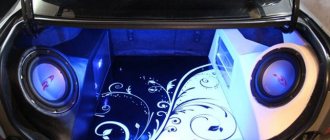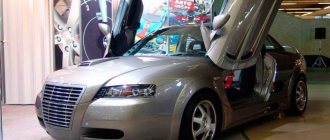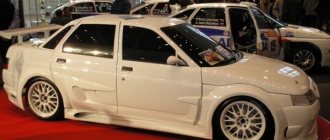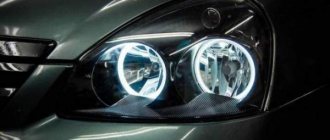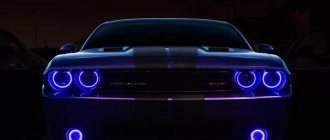When tuning a Mitsubishi Lancer 10, a car owner can pursue various goals. For example, styling changes the appearance of the car, which allows the car not only to stand out in traffic, but also in some cases significantly improves aerodynamic performance.
Tuning the interior allows you to equip the car at the request of the car owner, as well as improve sound insulation. Chip tuning allows you to unlock the potential inherent in the power plant.
There is also extreme tuning, for example, converting the body into a station wagon, hatchback or convertible. It should be borne in mind that if the appearance, optics or important control systems of the vehicle change significantly, problems may arise without the appropriate documentation.
External tuning Mitsubishi Lancer 10
Standard wheels are reliable and durable, but lack individuality. Therefore, many car owners begin tuning their Mitsubishi Lancer 10 by installing stock wheels. With such an improvement, the spring weight can be reduced, which will increase the comfort of movement in the car. There is also a large selection of forged wheels that can increase the safety of passing road obstacles. The cost ranges from 3,000 to 50 thousand rubles.
Tuning the front and rear bumpers usually involves installing trims. Their use is not only decorative, but also practical.
For example, a cover on the rear bumper protects the paintwork from mechanical damage that may occur during unsuccessful loading or unloading from the trunk. The price if made from metal starts from 5,000 rubles. If the overlay is made of plastic, then the cost ranges from 400 to 3000 rubles.
Installing an aerodynamic body kit has two purposes:
- creating a sporty look for the car;
- improve the streamlining of the car.
By reducing air resistance, it is possible not only to improve dynamic performance, but also to reduce fuel consumption. It should be borne in mind that this type of tuning can lead to completely the opposite result. Lancer X, leaving the factory, has fairly good aerodynamic performance, since a lot of engineers were involved in its design and testing.
Therefore, before installing a sports body kit, it is necessary to evaluate all the risks and feasibility of such an upgrade.
The price of the issue starts from several thousand rubles.
Also, during external tuning, an evolution grille, optics with LEDs, license plate pendants are installed, and pictures are applied to the surface of the body.
The engine will not start
You can start an engine with a fuel injection system like this: you need to turn on the starter, but you do not need to touch the accelerator pedal. The power unit control mechanism itself will set the appropriate parameters for starting (fuel supply and ignition timing).
- open the hood. To do this, pull the lock drive handle towards you.
- It is necessary to check the oil level with an oil dipstick.
- the indicator must be between the maximum and minimum values.
- carefully inspect the engine compartment, pay attention to gasoline or oil leaks. The electrical wiring must also be intact.
- get behind the wheel without closing the hood. Turn on the ignition. At this moment the fuel pump will turn on. Start the engine and then turn off the ignition.
- Perhaps for some reason you have such a problem - the spark plugs are “flooded”. In this case, it is necessary to use the cylinder purge mode. To do this, press the car accelerator pedal and turn on the starter. In this mode, there is no fuel supply, excess gasoline will be removed from the cylinders with fresh air, and the spark plugs will be dried. After finishing the purge, you need to try to start again in the usual manner.
Noise insulation
The problem with all Lancer 10s is too much extraneous sound in the cabin, so most car owners decide to soundproof them.
It is recommended to perform sound insulation for the following elements:
- All doors.
- Ceiling. There is a lot of space under the casing, so sheets of vibration-damping material can be easily climbed through. It is not necessary to completely remove the trim; simply move it back and forth as needed.
- Bottom. It is recommended to paste over several different layers.
- Rear arches. Minimum three layers.
- Trunk. It is recommended to paste in several layers.
When carrying out soundproofing at a car service center, the cost of soundproofing a Mitsubishi interior ranges from 20 to 30 thousand rubles. If you do everything yourself with your own hands using materials from “Egoist”, then the price of modernization will vary from 10 to 16 thousand rubles. If difficulties arise, it is recommended to watch the video.
Bumper update
By doing it yourself, a car enthusiast can improve its appearance, literally update it. Sometimes it is enough to turn on a hair dryer and slowly move a stream of hot air over the surface of the part. From its influence, small cracks are eliminated, and the paint acquires its lost brightness.
You can also update the bumper if scratches appear on its surface. In this case, the damaged area can be cleaned down to primer or plastic. Degrease the cleaned surface. Tint the prepared area using an aerosol of the desired color. Today you can easily buy such an aerosol in a car store.
WATCH VIDEO INSTRUCTIONS
If the damage is more serious, in the form of a small crack, this deficiency can be eliminated by sealing the prepared area with a metal mesh made of thin wire with small cells. In this case, the plastic of the bumper warms up in the right place so that the mesh can be pressed onto the damaged area. Then the mesh is coated with epoxy and painted over.
Interior improvement
A tuned interior allows you to make your car unique. It can affect any element of the interior, for example, the steering wheel. As a rule, in this case, the design is created in a certain style, for example, silver or “wood”, as in the photo below.
Many car owners use lighting to create an exclusive look for the car interior. In this case, it is necessary to take into account the increasing load on the machine generator.
The price for interior tuning has a very wide range. So installing an additional LED backlight can cost several rubles. The use of gold, velvet, wood or other exclusive materials can exceed the cost of the Lancer 10 Sportback car.
Repair/maintenance/disassembly
Body
- How to remove the front bumper
- How to remove the rear bumper
- Bumper Crack Repair
- Replacing the check valve in the windshield washer system
Engine
- Engine repair 4A91 (ring coking, valve burnout)
Chassis
- Replacing front shock absorber struts
Electrical and electronics
- How to remove the stock radio
- Repair of a standard radio (CD plays on one channel)
- False oxygen sensor (lambda probe)
This is interesting: Bumper for Honda Accord 7: how to remove, restyling
Improvement of the dashboard on the Mitsubishi Lancer 10
Since 2008, the first Lancer 10 cars went on sale. They had a dashboard with a monochrome on-board computer display. Car owners of these cars very often change the panel to more modern restyled versions.
First dashboard
After the first Lancer restyling, the speedometer and tachometer were replaced on the dashboard. The design of the elements displaying information has also changed. Examples of instrument panels are shown in the images.
Restyled instrument panel
Subsequently, the dashboard received a color display of the on-board computer. The readability of information has also improved. Therefore, this panel is most often used for tuning. The cost of such modernization ranges from 7 to 25 thousand rubles.
Instrument panel with color display of on-board computer
How samurai are born
This is how the Colt Lancer was produced until 1975, until the new model more or less found its feet and gained fame. And the cars were built mainly for export. It was this version of '75 that was very actively sold in the States and in Australia, although under the Dodge, Chrysler and Plymouth brands. The car received a lot of bodies and had a sea of modifications with a variety of engines. From the budget 1.2-liter to the semi-sports 1.6-liter version. Then the Lancer entered the race track for the first time. Our public is more familiar with the Lancers of the early 80s. Angular and practical Japanese, who practically did not break down and gained the trust of our motorists.
Later, when representative offices began to open, there was an opportunity to buy a new seventh-generation Lancer, which won gold in the world rally championships four times in a row. True, the civilian version was very different from the sports all-wheel drive Evolution, but cars with all-wheel drive were also available for sale. But only in a station wagon. During the collaboration with General Motors, thanks to the efforts of Olivier Bullet, all Mitsubishi received original noses, but after the termination of work with GM, the cars again returned to the classic design of the Japanese school. Which obviously worked to their advantage.
Chip tuning
The advantage of chip tuning is that in case of failure, you can return everything to factory settings. The downside is that prolonged use of a car with incorrect flashing will lead to excessive wear on the engine and gearbox. Therefore, you should be responsible when programming the electronic control unit.
The chip tuning sequence is as follows:
- Reading the factory program.
- Analysis of the obtained data.
- Selection of the required firmware.
- Alteration.
As a rule, chip tuning allows you to achieve one of the goals:
- elimination of factory defects;
- customizing the car for a specific owner;
- improvement of dynamic performance;
- increased efficiency.
When a car leaves the factory, it has mediocre performance. This is due to the search for a golden mean between efficiency, dynamism and environmental friendliness. Different emission standards force the manufacturer to stifle and degrade the power plant of the Lancer 10. Re-flashing the brain allows you to return the built-in power. If you flash the firmware yourself, this operation is free. Contacting the studio will cost 5 - 25 thousand rubles.
Reviews from car owners
Mitsubishi engines are more or less afraid of overheating. The driver’s tasks include regularly checking the condition of the cooling system, which includes cleaning the radiator honeycombs from dust and dirt. It is important to monitor the operation of the pump and thermostat. Often these elements of the cooling system fail prematurely, subsequently causing the driver considerable trouble. If overheating could not be avoided, then there is no need to immediately pour coolant into the expansion tank. It is necessary to cool the installation evenly, otherwise cracks and other deformations on the surface of the cylinder head and block cannot be avoided. The owners of the Japanese sedan will tell you in detail about the actual service life of the Mitsubishi Lancer engine.
Mitsubishi Lancer 9th generation
- Egor, Moscow. Hi all! I drive a 9th generation Mitsubishi Lancer, produced in 2007. Under the hood is an engine with a displacement of 1.3 liters, marked 4G13. The mileage to date is 210 thousand kilometers. As for the resource, this concept is flexible. How long the installation will last is influenced by multiple factors: timely replacement of consumables, high-quality oil and fuel. In general, Japanese engines are designed to last a million kilometers, experienced auto mechanics have told me this more than once. But in our operating conditions, a mileage of 300-350 thousand is considered a good indicator. During the time I owned the sedan, there were no problems with the engine (rings stuck, etc.). I don't add oil.
- Sergey, Cheboksary. I myself drive a 9th generation Mitsubishi Lancer with a 4G18 engine. I have had the car since 2009, bought it on the secondary market with a mileage of 50 thousand. The odometer now shows 190,000 kilometers. Recently I noticed an increase in engine oil consumption. I went to the service station to conduct a full diagnostic of the car. The technicians said that the oil scraper and piston rings needed to be changed. They replaced it, the repairs were expensive, but overall the engine began to work better, and most importantly, consumption returned to normal. They said that the repairs were due to low-quality oil and fuel, although I always filled it with Mobil 5W30. According to the idea, a resource of 350-380 thousand is quite realistic.
- Valentin, Moscow. If you take care of the car, there will be no oil waste. Most car owners who complain about increased lubricant consumption do not even know the actual mileage of the car (2-3 hands with an unscrewed mileage). I have a 2006 Mitsubishi Lancer 2.0 4G63 engine. I haven’t changed the rings, everything is original, the mileage is already 200,000 kilometers. I only fill with Mobil oil, I refuel with Lukoil AI-92. For those drivers who cannot do anything about the “appetite” of the engine, I advise you to replace the cylinder head. You can easily find a cylinder head on the secondary market in good condition. The car will drive completely differently afterwards.
- Alexander, Murmansk. I purchased a Mitsubishi Lancer in 2005, a ninth generation model, with a two-liter 4G63 engine under the hood. I have no complaints about the build quality of the car or the reliability of the engine. Everything is done at the highest level, as befits the Japanese automotive industry. I would like to give some recommendations to fans of Japanese cars. I have had the car for more than 10 years, and during this time I have driven 250,000 kilometers on it. It would seem that the engine's life is coming to an end, but this is not at all the case. The installation looks like new, it works smoothly, quietly, I had it diagnosed, the technicians said that the machine was in good condition. So how did I manage to keep the car? Firstly, change the oil strictly every 7,500 km. I've been using Motul 5W30 all my life. Secondly, only original air and fuel filters. That's all! The effectiveness of this service has been verified by me personally.
- Evgeniy, Tula. I agree that how the driver treats the car is how the vehicle will work. You can put the engine in 50 thousand km, or you can go half a million. Service and once again quality service. Personally, I have a Mitsubishi Lancer 9 with a 4G18 engine. Now the mileage is 185,000 kilometers. There is no need to add oil from change to change. My driving style is constant: I can drive calmly, but if the need arises, I’ll press the “sneakers” into the floor. Minor repairs to the power unit were carried out only after 130k: replacing the caps. The timing belt was replaced after 90 thousand km.
- Anatoly, Kirov. I have not had the best experience with the Mitsubishi Lancer sedan. The first car was sold with a mileage of 220 thousand km. The engine worked perfectly, compression in the cylinders was normal, but I constantly had to add 200-250 grams of oil every thousand kilometers. Now I have a tenth generation Mitsubishi Lancer. I am completely satisfied with the car.
Power plant tuning
Regardless of which motor is installed on the Lancer 10, intervention in its design can significantly increase power. The table below shows the power obtained without reducing the resource and with its loss within reason. It should be borne in mind that stock spare parts in most cases have a shorter service life than the originals. Unlike chip tuning, constructive interference is more difficult to correct. In some cases, it is cheaper to purchase a new or contract engine than to fix a tuned one.
| Engine capacity | Rated power, hp | Without significant loss of resource, hp. | Maximum power with loss of life within reasonable limits, hp. |
| 1,5 | 109 | 117 | 125 |
| 1,6 | 117 | 125 | 130 |
| 1,8 | 143 | 152 | 160 |
| 2.0 | 150 | 160 | 170 |
Often engine upgrades are accompanied by changes to the exhaust. Many parts are used from evolution. The cost of tuning ranges from 10 to 70 thousand rubles.
Gradual increase in power (question)
Gradual increase in power (question)
#1 Unread message Alex » Fri May 08, 2009 12:32 am
#2 Unread message R0gue » Fri May 08, 2009 12:47 am
for 2 liters Boy's version: Chip ;0 and forward flow 155-160 hp in theory (forward flow gives 0.1 hp) Normal option: New sports camshafts (for example JUN), Spider, new intake (in principle, you don’t have to do it), blende instead of catalytic converter, at the end there is a chip. Somewhere around 170-200 in theory Extreme option: turbo kit or throttles)))
for 1.8 everything is the same, but only + replacement of the crankshaft and piston)
for 1.5 Butovo sticker, orange mudguards, Evo spoiler, tinted optics
I'm saying this from my pseudo-amateur level.
#3 Unread message Alex » Fri May 08, 2009 1:02 am
R0gue wrote: for 1.5 Butovo sticker, orange mudguards, Evo spoiler, tinted Laughing optics
Thank you
#4 Unread message Shark » Fri May 08, 2009 8:45 am
1.5 MT is practically not inferior to 1.8 CVT in terms of dynamics
These guys are sluggish
1.8 on the handle is a different matter.
PS Don't underestimate 1.5
Source




